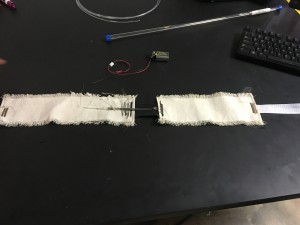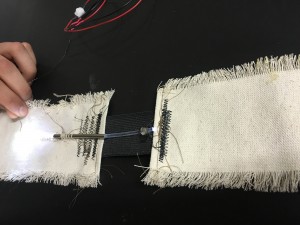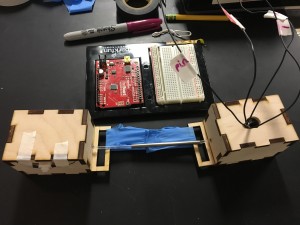Week three: June 24, 2016
Lucas Gutembergue da Costa
During this week I spent most of my time working with team Toco, which is composed by me, Nathalie, Zach and Chimwemwe. Our goal is to create a low-cost tocodynamometer that will be used in developing countries. A tocodynamometer is a device used to detect and measure uterine contractions of a pregnant woman during labor.
We started with a proof of concept developed by Dr. Carns (shown below). It consists of two pieces of fiber optic cable that touch each other covered by hypotube. The two pieces of fiber optic cable are attached to fabric and there is an LED in one end of the fiber optic and a photoresistor on the other end. The fabric ends are attached to the woman’s belly and as the belly stretches because of the contractions the fiber optic cables separate causing the amount of light going through the cables to decrease. This decrease is detected by the photoresistor therefore we know that a contraction has happened.
Fig 1 and 2 – Low fidelity prototype of the Optoco made by Dr. Carns
We started by doing research on the background of our problem, the different devices currently in the marker to monitor uterine contractions, regulations and patents. Then we defined our design criteria and design constraints, brainstormed solutions and selected the best solution using a scoring matrix.
Then we made a medium fidelity prototype based on Dr. Carns idea to evaluate the sensitivity of the device, i.e. how much the voltage reading from the photoresistor changes as the device is displaced. The prototype was made by laser cutting wood boxes to hold the LED and the photoresistor, with the same assembly of fiber optic cable and hypotube in the middle. The circuit is powered by the Arduino and the voltage reading is recorded by the Arduino too. The preliminary results of the device’s sensitivity are very optimistic.
Fig 3 – Medium fidelity prototype
The next steps for the Optoco are to process the data we receive from the photoresistor and output the data the doctors and nurses want. This will involve creating an algorithm to process the information.


